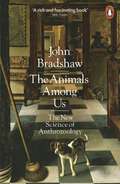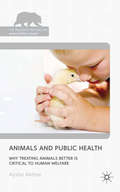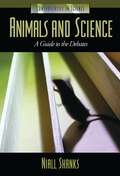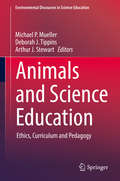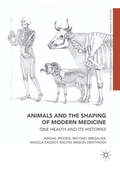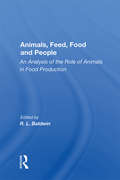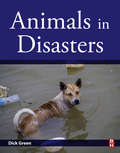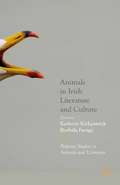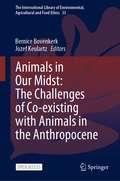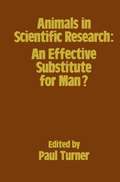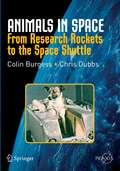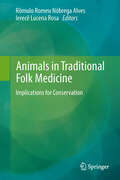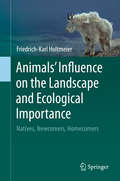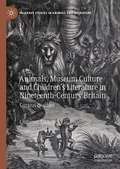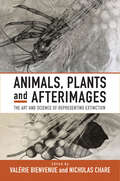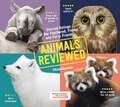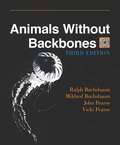- Table View
- List View
The Animals Among Us: The New Science of Anthrozoology
by John Bradshaw'A pioneering study ... richly, empathetically and affectionately respectful of the human-animal bond' Sunday TimesWhy do humans love animals? The bestselling author of In Defence of Dogs and Cat Sense gives us the answers.Keeping pets is expensive, time-consuming, and seemingly irrational - so why do so many of us have an animal in our lives?Modern-day pet-keeping has been justified for many reasons, from the potential therapeutic role pets can play, to their appealing 'cuteness'. But pet-keeping is much more than just a simple pastime. It is part of the broader history of humanity's relationship with animals - a relationship that comes from deep within our nature. As John Bradshaw reveals in this highly original new work, our connection with animals is one of the very things that makes us human. In The Animals Among Us, Bradshaw takes us to the heart of Anthrozoology, a new science dedicated to discovering the true nature and depth of the human-animal bond. Following the thread of our affection for animals, from today's pet lovers all the way back to our ancient ancestors, Bradshaw reveals how animals have always been an integral part of our lives: indeed, they have shaped the evolution of our minds and our bodies. The ways in which we relate to animals today stem ultimately from our evolutionary journey from hominid to Homo sapiens.An affinity for animals drove our evolution as humans. Now, as increasing numbers of species are under threat, John Bradshaw shows us that pet-keeping can act as a bridge between the domestic and the wild, even aiding conservation. If we lose the animals among us, he warns, we risk losing an essential part of ourselves.
Animals and Medicine: The Contribution Of Animal Experiments To The Control Of Disease
by Jack Botting edited by Regina BottingAnimals and Medicine: The Contribution of Animal Experiments to the Control of Disease offers a detailed, scholarly historical review of the critical role animal experiments have played in advancing medical knowledge. Laboratory animals have been essential to this progress, and the knowledge gained has saved countless lives—both human and animal. Unfortunately, those opposed to using animals in research have often employed doctored evidence to suggest that the practice has impeded medical progress. This volume presents the articles Jack Botting wrote for the Research Defence Society News from 1991 to 1996, papers which provided scientists with the information needed to rebut such claims. Collected, they can now reach a wider readership interested in understanding the part of animal experiments in the history of medicine—from the discovery of key vaccines to the advancement of research on a range of diseases, among them hypertension, kidney failure and cancer. This book is essential reading for anyone curious about the role of animal experimentation in the history of science from the nineteenth century to the present.
Animals and Public Health: Why Treating Animals Better is Critical to Human Welfare (The Palgrave Macmillan Animal Ethics Series)
by A. AkhtarA compelling argument of how human health is adversely affected by our poor treatment of non-human animals. The author contents that in order to successfully confront the 21st Century's health challenges, we need to broaden the definition of the word 'public' in public health to include non-human animals.
Animals and Science: A Guide to the Debates (Controversies in Science)
by Niall ShanksAnimals and Science examines the debates, from the Renaissance to the present, surrounding issues of animal rights, consciousness, and self-awareness.Animals and Science examines what science has (and has not) taught us about the nature of nonhuman animals and explores the moral, religious, social, and scientific implications of those teachings. It shows how the scientific study of animals, especially their cognitive abilities, has transformed our understanding of them. Animals and Science traces our evolving understanding of animal pain and considers its moral relevance to humans. It discusses Darwin's belief-shattering notion that species differences are not absolute, then traces its impact to the present day.Ultimately, Animals and Science is about the nature of science—the kinds of questions science can and cannot answer, and the role of theory in shaping the interpretation of evidence.
Animals and Science Education: Ethics, Curriculum and Pedagogy (Environmental Discourses in Science Education #2)
by Michael P. Mueller Deborah J. Tippins Arthur J. StewartThis book discusses how we can inspire today’s youth to engage in challenging and productive discussions around the past, present and future role of animals in science education. Animals play a large role in the sciences and science education and yet they remain one of the least visible topics in the educational literature. This book is intended to cultivate research topics, conversations, and dispositions for the ethical use of animals in science and education. This book explores the vital role of animals with/in science education, specimens, protected species, and other associated issues with regards to the role of animals in science. Topics explored include ethical, curriculum and pedagogical dimensions, involving invertebrates, engineering solutions that contribute to ecosystems, the experiences of animals under our care, aesthetic and contemplative practices alongside science, school-based ethical dialogue, nature study for promoting inquiry and sustainability, the challenge of whether animals need to be used for science whatsoever, reconceptualizing museum specimens, cultivating socioscientific issues and epistemic practice, cultural integrity and citizen science, the care and nurturance of gender-balanced curriculum choices for science education, and theoretical conversations around cultivating critical thinking skills and ethical dispositions. The diverse authors in this book take on the logic of domination and symbolic violence embodied within the scientific enterprise that has systematically subjugated animals and nature, and emboldened the anthropocentric and exploitative expressions for the future role of animals.At a time when animals are getting excluded from classrooms (too dangerous! too many allergies! too dirty!), this book is an important counterpoint. Interacting with animals helps students develop empathy, learn to care for living things, engage with content. We need more animals in the science curriculum, not less.David Sobel, Senior Faculty, Education Department, Antioch University New England
Animals and the Shaping of Modern Medicine: One Health and its Histories
by Angela Cassidy Abigail Woods Michael Bresalier Rachel Mason DentingerThis book is open access under a CC BY 4.0 license.This book breaks new ground by situating animals and their diseases at the very heart of modern medicine. In demonstrating their historical significance as subjects and shapers of medicine, it offers important insights into past animal lives, and reveals that what we think of as ‘human’ medicine was in fact deeply zoological.Each chapter analyses an important episode in which animals changed and were changed by medicine. Ranging across the animal inhabitants of Britain’s zoos, sick sheep on Scottish farms, unproductive livestock in developing countries, and the tapeworms of California and Beirut, they illuminate the multi-species dimensions of modern medicine and its rich historical connections with biology, zoology, agriculture and veterinary medicine. The modern movement for One Health – whose history is also analyzed – is therefore revealed as just the latest attempt to improve health by working across species and disciplines. This book will appeal to historians of animals, science and medicine, to those involved in the promotion and practice of One Health today.
Animals and the Shaping of Modern Medicine: One Health and its Histories
by Abigail Woods Michael Bresalier Angela Cassidy Rachel Mason DentingerThis book is open access under a CC BY 4.0 license.This book breaks new ground by situating animals and their diseases at the very heart of modern medicine. In demonstrating their historical significance as subjects and shapers of medicine, it offers important insights into past animal lives, and reveals that what we think of as ‘human’ medicine was in fact deeply zoological.Each chapter analyses an important episode in which animals changed and were changed by medicine. Ranging across the animal inhabitants of Britain’s zoos, sick sheep on Scottish farms, unproductive livestock in developing countries, and the tapeworms of California and Beirut, they illuminate the multi-species dimensions of modern medicine and its rich historical connections with biology, zoology, agriculture and veterinary medicine. The modern movement for One Health – whose history is also analyzed – is therefore revealed as just the latest attempt to improve health by working across species and disciplines. This book will appeal to historians of animals, science and medicine, to those involved in the promotion and practice of One Health today.
Animals, Feed, Food And People: An Analysis Of The Role Of Animals In Food Production
by R. L. BaldwinNumerous authors have presented analyses of the world food problem and the appropriate role of animals in food production and have drawn qualitative conclusions. However, projection and planning require quantitative considerations, and this volume addresses that challenge. Experts in animal science, farm management, economics, international agriculture, and nutrition elucidate and debate germane issues with scientific rigor. They examine the efficiency and economics of animal production, feed resource availability, interactions between plant and animal agricultures, international trade, resource allocation, roles of animals in developing countries, and the nutritional values and limitations of animal products.
Animals, Feed, Food And People: An Analysis Of The Role Of Animals In Food Production
by R. L. BaldwinNumerous authors have presented analyses of the world food problem and the appropriate role of animals in food production and have drawn qualitative conclusions. However, projection and planning require quantitative considerations, and this volume addresses that challenge. Experts in animal science, farm management, economics, international agriculture, and nutrition elucidate and debate germane issues with scientific rigor. They examine the efficiency and economics of animal production, feed resource availability, interactions between plant and animal agricultures, international trade, resource allocation, roles of animals in developing countries, and the nutritional values and limitations of animal products.
Animals in Disasters
by Dick GreenAnimals in Disasters is a comprehensive book on animal rescue written by Dr. Dick Green who shares his experiences, best practices and lessons learned from well over 125 domestic and international disasters. It provides a step-by-step process for communities and states to more effectively address animal issues and enhance their animal response capabilities. Sections include an overview of the history of animal rescue, where we are today, and the steps needed to better prepare for tomorrow. This how-to book for emergency managers who want to develop programs, craft policy, and build response capability/capacity is an ideal companion to their work. Clearly identifies the components of building a resilient communityIntroduces the Community Preparedness ChecklistHelps readers develop and deliver effective animal response training
Animals in Irish Literature and Culture (Palgrave Studies in Animals and Literature)
by Kathryn Kirkpatrick Borbála FaragóAnimals in Irish Literature and Culture spans the early modern period to the present, exploring colonial, post-colonial, and globalized manifestations of Ireland as country and state as well as the human animal and non-human animal migrations that challenge a variety of literal and cultural borders.
Animals in Our Midst: The Challenges of Co-existing with Animals in the Anthropocene (The International Library of Environmental, Agricultural and Food Ethics #33)
by Bernice Bovenkerk Jozef KeulartzThis Open Access book brings together authoritative voices in animal and environmental ethics, who address the many different facets of changing human-animal relationships in the Anthropocene. As we are living in complex times, the issue of how to establish meaningful relationships with other animals under Anthropocene conditions needs to be approached from a multitude of angles. This book offers the reader insight into the different discussions that exist around the topics of how we should understand animal agency, how we could take animal agency seriously in farms, urban areas and the wild, and what technologies are appropriate and morally desirable to use regarding animals. This book is of interest to both animal studies scholars and environmental ethics scholars, as well as to practitioners working with animals, such as wildlife managers, zookeepers, and conservation biologists.
Animals in Scientific Research (pdf): Proceedings of a Symposium held in April 1982 under the auspices of the Humane Research Trust
by P. TurnerAnimals in Space: From Research Rockets to the Space Shuttle (Springer Praxis Books)
by Colin Burgess Chris DubbsThis book is as a detailed, but highly readable and balanced account of the history of animal space flights carried out by all nations, but principally the United States and the Soviet Union. It explores the ways in which animal high-altitude and space flight research impacted on space flight biomedicine and technology, and how the results - both successful and disappointing - allowed human beings to then undertake that same hazardous journey with far greater understanding and confidence. This complete and authoritative book will undoubtedly become the ultimate authority on animal space flights.
Animals in Traditional Folk Medicine: Implications for Conservation
by Rômulo Romeu Nóbrega Alves and Ierecê Lucena RosaPeople have relied on medicinal products derived from natural sources for millennia, and animals have long been an important part of that repertoire; nearly all cultures, from ancient times to the present, have used animals as a source of medicine. Ingredients derived from wild animals are not only widely used in traditional remedies, but are also increasingly valued as raw materials in the preparation of modern medicines. Regrettably, the unsustainable use of plants and animals in traditional medicine is recognized as a threat to wildlife conservation, as a result of which discussions concerning the links between traditional medicine and biodiversity are becoming increasingly imperative, particularly in view of the fact that folk medicine is the primary source of health care for 80% of the world’s population. This book discusses the role of animals in traditional folk medicine and its meaning for wildlife conservation. We hope to further stimulate further discussions about the use of biodiversity and its implications for wildlife conservation strategies.
Animals' Influence on the Landscape and Ecological Importance: Natives, Newcomers, Homecomers
by Friedrich-Karl HoltmeierIn its first English-language edition, this book introduces the many-faceted interactions of animal populations with their habitats. From soil fauna, ants and termites to small and large herbivores, burrowing mammals and birds, the author presents a comprehensive analysis of animals and ecosystems that is as broad and varied as all nature. Chapter 2 addresses the functional role of animals in landscape ecosystems, emphasizing fluxes of energy and matter within and between ecosystems, and the effects of animals on qualitative and structural habitat change. Discussion includes chapters on the role of animal population density and the impacts of native herbivores on vegetation and habitats from the tropics to the polar regions. Cyclic mass outbreaks of species such as the larch bud moth in Switzerland, the mountain pine beetle and the African red-billed weaver bird are described and analyzed. Other chapters discuss Zoochory – the dispersal of seeds by ants, mammals and birds – and the influence of burrowing animals on soil development and geomorphology. Consideration extends to the impact of feral domestic animals. Chapter 5 focuses on problems resulting from introduction of alien animals and from re-introduction of animal species to their original habitats, discusses the effects on ecosystems of burrowing, digging and trampling by animals. The author also addresses keystone species such as kangaroo rats, termites and beavers. Chapter 6 addresses the role of animals in landscape management and nature conservation, with chapters on the impact of newcomer species such as animals introduced into Australia, New Zealand and Europe, and the consequences of reintroduction of species to original habitat. It also discusses the carrying capacity of natural habit, public attitudes toward conversation and more. The final section ponders the effects of climate on interactions between animals and their habitats.
Animals, Museum Culture and Children’s Literature in Nineteenth-Century Britain: Curious Beasties (Palgrave Studies in Animals and Literature)
by Laurence TalairachAnimals, Museum Culture and Children’s Literature in Nineteenth-Century Britain: Curious Beasties explores the relationship between the zoological and palaeontological specimens brought back from around the world in the long nineteenth century—be they alive, stuffed or fossilised—and the development of children’s literature at this time. Children’s literature emerged as dizzying numbers of new species flooded into Britain with scientific expeditions, from giraffes and hippopotami to kangaroos, wombats, platypuses or sloths. As the book argues, late Georgian, Victorian and Edwardian children’s writers took part in the urge for mass education and presented the world and its curious creatures to children, often borrowing from their museum culture and its objects to map out that world. This original exploration illuminates how children’s literature dealt with the new ordering of the world, offering a unique viewpoint on the construction of science in the long nineteenth century.
Animals, Plants and Afterimages: The Art and Science of Representing Extinction
by Valérie Bienvenue Nicholas ChareThe sixth mass extinction or Anthropocene extinction is one of the most pervasive issues of our time. Animals, Plants and Afterimages brings together leading scholars in the humanities and life sciences to explore how extinct species are represented in art and visual culture, with a special emphasis on museums. Engaging with celebrated cases of vanished species such as the quagga and the thylacine as well as less well-known examples of animals and plants, these essays explore how representations of recent and ancient extinctions help advance scientific understanding and speak to contemporary ecological and environmental concerns.
Animals, Plants and Afterimages: The Art and Science of Representing Extinction
by Nicholas Chare Valérie BienvenueThe sixth mass extinction or Anthropocene extinction is one of the most pervasive issues of our time. Animals, Plants and Afterimages brings together leading scholars in the humanities and life sciences to explore how extinct species are represented in art and visual culture, with a special emphasis on museums. Engaging with celebrated cases of vanished species such as the quagga and the thylacine as well as less well-known examples of animals and plants, these essays explore how representations of recent and ancient extinctions help advance scientific understanding and speak to contemporary ecological and environmental concerns.
Animals, Plants and Afterimages: The Art and Science of Representing Extinction
by Nicholas Chare Valérie BienvenueThe sixth mass extinction or Anthropocene extinction is one of the most pervasive issues of our time. Animals, Plants and Afterimages brings together leading scholars in the humanities and life sciences to explore how extinct species are represented in art and visual culture, with a special emphasis on museums. Engaging with celebrated cases of vanished species such as the quagga and the thylacine as well as less well-known examples of animals and plants, these essays explore how representations of recent and ancient extinctions help advance scientific understanding and speak to contemporary ecological and environmental concerns.
Animals Reviewed: Starred Ratings of Our Feathered, Finned, and Furry Friends
by Association of Zoos and AquariumsZookeepers hilariously review the animals in their keep—from the anxious aardvark to the zealous zebra shark and every animal in between.
Animals Without Backbones: An Introduction to the Invertebrates (New Plan Texts at the University of Chicago)
by Ralph Buchsbaum Mildred Buchsbaum John Pearse Vicki PearseAnimals Without Backbones has been considered a classic among biology textbooks since it was first published to great acclaim in 1938. It was the first biology textbook ever reviewed by Time and was also featured with illustrations in Life. Harvard, Stanford, the University of Chicago, and more than eighty other colleges and universities adopted it for use in courses. Since then, its clear explanations and ample illustrations have continued to introduce hundreds of thousands of students and general readers around the world to jellyfishes, corals, flatworms, squids, starfishes, spiders, grasshoppers, and the other invertebrates that make up ninety-seven percent of the animal kingdom. This new edition has been completely rewritten and redesigned, but it retains the same clarity and careful scholarship that have earned this book its continuing readership for half a century. It is even more lavishly illustrated than earlier editions, incorporating many new drawings and photographs. Informative, concise legends that form an integral part of the text accompany the illustrations. The text has been updated to include findings from recent research. Eschewing pure morphology, the authors use each group of animals to introduce one or more biological principles. In recent decades, courses and texts on invertebrate zoology at many universities have been available only for advanced biology majors specializing in this area. The Third Edition of Animals Without Backbones remains an ideal introduction to invertebrates for lower-level biology majors, nonmajors, students in paleontology and other related fields, junior college and advanced high school students, and the general reader who pursues the rewarding study of the natural world.
Animals Without Backbones: An Introduction to the Invertebrates (New Plan Texts at the University of Chicago)
by Ralph Buchsbaum Mildred Buchsbaum John Pearse Vicki PearseAnimals Without Backbones has been considered a classic among biology textbooks since it was first published to great acclaim in 1938. It was the first biology textbook ever reviewed by Time and was also featured with illustrations in Life. Harvard, Stanford, the University of Chicago, and more than eighty other colleges and universities adopted it for use in courses. Since then, its clear explanations and ample illustrations have continued to introduce hundreds of thousands of students and general readers around the world to jellyfishes, corals, flatworms, squids, starfishes, spiders, grasshoppers, and the other invertebrates that make up ninety-seven percent of the animal kingdom. This new edition has been completely rewritten and redesigned, but it retains the same clarity and careful scholarship that have earned this book its continuing readership for half a century. It is even more lavishly illustrated than earlier editions, incorporating many new drawings and photographs. Informative, concise legends that form an integral part of the text accompany the illustrations. The text has been updated to include findings from recent research. Eschewing pure morphology, the authors use each group of animals to introduce one or more biological principles. In recent decades, courses and texts on invertebrate zoology at many universities have been available only for advanced biology majors specializing in this area. The Third Edition of Animals Without Backbones remains an ideal introduction to invertebrates for lower-level biology majors, nonmajors, students in paleontology and other related fields, junior college and advanced high school students, and the general reader who pursues the rewarding study of the natural world.
Animals Without Backbones: An Introduction to the Invertebrates (New Plan Texts at the University of Chicago)
by Ralph Buchsbaum Mildred Buchsbaum John Pearse Vicki PearseAnimals Without Backbones has been considered a classic among biology textbooks since it was first published to great acclaim in 1938. It was the first biology textbook ever reviewed by Time and was also featured with illustrations in Life. Harvard, Stanford, the University of Chicago, and more than eighty other colleges and universities adopted it for use in courses. Since then, its clear explanations and ample illustrations have continued to introduce hundreds of thousands of students and general readers around the world to jellyfishes, corals, flatworms, squids, starfishes, spiders, grasshoppers, and the other invertebrates that make up ninety-seven percent of the animal kingdom. This new edition has been completely rewritten and redesigned, but it retains the same clarity and careful scholarship that have earned this book its continuing readership for half a century. It is even more lavishly illustrated than earlier editions, incorporating many new drawings and photographs. Informative, concise legends that form an integral part of the text accompany the illustrations. The text has been updated to include findings from recent research. Eschewing pure morphology, the authors use each group of animals to introduce one or more biological principles. In recent decades, courses and texts on invertebrate zoology at many universities have been available only for advanced biology majors specializing in this area. The Third Edition of Animals Without Backbones remains an ideal introduction to invertebrates for lower-level biology majors, nonmajors, students in paleontology and other related fields, junior college and advanced high school students, and the general reader who pursues the rewarding study of the natural world.
Animals Without Backbones: An Introduction to the Invertebrates (New Plan Texts at the University of Chicago)
by Ralph Buchsbaum Mildred Buchsbaum John Pearse Vicki PearseAnimals Without Backbones has been considered a classic among biology textbooks since it was first published to great acclaim in 1938. It was the first biology textbook ever reviewed by Time and was also featured with illustrations in Life. Harvard, Stanford, the University of Chicago, and more than eighty other colleges and universities adopted it for use in courses. Since then, its clear explanations and ample illustrations have continued to introduce hundreds of thousands of students and general readers around the world to jellyfishes, corals, flatworms, squids, starfishes, spiders, grasshoppers, and the other invertebrates that make up ninety-seven percent of the animal kingdom. This new edition has been completely rewritten and redesigned, but it retains the same clarity and careful scholarship that have earned this book its continuing readership for half a century. It is even more lavishly illustrated than earlier editions, incorporating many new drawings and photographs. Informative, concise legends that form an integral part of the text accompany the illustrations. The text has been updated to include findings from recent research. Eschewing pure morphology, the authors use each group of animals to introduce one or more biological principles. In recent decades, courses and texts on invertebrate zoology at many universities have been available only for advanced biology majors specializing in this area. The Third Edition of Animals Without Backbones remains an ideal introduction to invertebrates for lower-level biology majors, nonmajors, students in paleontology and other related fields, junior college and advanced high school students, and the general reader who pursues the rewarding study of the natural world.
